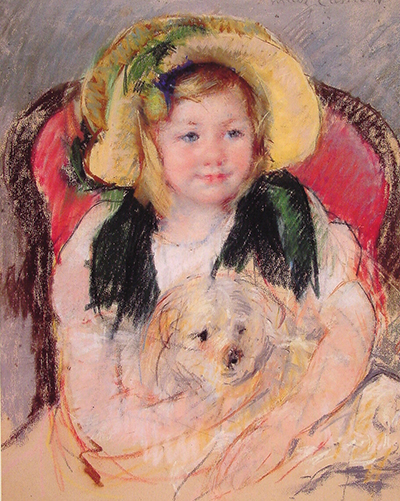This pastel portrait was produced in 1901, by which time Mary Cassatt had been working within this medium for a number of decades. She worked alongside Degas across the 1890s and encouraged each other to take this form of drawing just as far as it could go.
This piece is now believed to be within a private collection and that perhaps explains why we do not know too much about it. In general terms, the artworks which made their way into public collections tend to have been researched far more deeply and also more frequently feature within publications on the artist's career. We are therefore left with having to just describe the piece as we see it here in front of us, and then place it within her overall oeuvre. We find a young girl looking across to our right, sat on a chair. The adult-sized chair looks enormous in comparison to her own frame, and she holds onto a small dog who is loosely drawn. Sara, as the title identifies her, wears a pretty hat which has some decorative elements, along with a dark green scarf. Her dress is pink, but without much detail other than some clear lines to create form and some rough plains of colour. Even her arms are left unfinished, but the artist would often do this, and just concentrate on the key facial features of her subject.
The background is a pastel tone of perhaps light blue, but many areas of this artwork are thin enough to allow the original paper colour to show through from beneath. Her cheeks are plump, her hair blonde and the blue eyes complete a look which Cassatt regularly went for when selecting suitable models for her portraits. She relied on the children of friends and family for a period of years before they all collectively grew up and she was forced to source children from elsewhere. Mothers and their children became a common genre within her output, probably the most common of all and Cassatt was able to represent the female gender effectively within the Impressionist movement, which was dominated by men. She was also joined by a few other women who were eventually accepted into the group and encouraged to exhibit alongside some of the great masters of the 19th century, such as Monet, Manet and Degas.
The latter of those influenced some of the pastel work of Cassatt, but he himself also took onboard ideas of hers, as they shared a friendship on an equal footing. She had previously studied his work in her younger years and so to work alongside him, exchanging ideas as they went, would have been an incredible feeling for her. Cassatt was unique in her identity, both as a woman but also as an American, and both would cause her issues for a number of years in terms of being accepted, but eventually her strong will and excellent technical ability would see her win out. Today there has been a greater willingness to discuss and promote her career, and we can celebrate the unique elements that she brought to the highly influential Impressionist movement.




